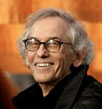|
The celebrated artist Christo, whose acclaim in the world of environmental art looms as large as his world-renowned installations, will appear at SUNY Fredonia this fall as a guest of the college’s Department of Visual Arts and New Media as a part of the campus’ Inauguration Week activities.
“This is a rare opportunity to bring one of the most internationally renowned visual artists to our campus,” said Distinguished Professor of Visual Arts and New Media Alberto Rey. “Each of his projects receives a tremendous amount of international recognition in the media and the art world. His work has changed the way many people look at the idea of ‘art’.”
Christo will deliver a lecture/slide presentation Tuesday, Sept. 18, at 7 p.m. in King Concert Hall. It is free and open to the public, but tickets are required and are available at the campus Ticket Office.
Christo’s visit has been made possible by a generous gift from Cathy Marion (’79), director of the Marion Foundation and a member of the Fredonia College Foundation Board of Directors, and her husband, Jesse Marion, president of Marion Investments. The couple, whose previous generosity to campus is reflected in the recently renovated Marion Art Gallery in the Rockefeller Arts Center, is thrilled to be able to bring such a globally celebrated artist to Fredonia.
Born in Bulgaria in 1935, Christo studied in Sofia and in Vienna and was a portrait artist in Paris, where he met his future wife and collaborator, Jeanne-Claude. In 1964, they relocated to New York City. His earliest sculptures were made of bottles and cans that were sometimes wrapped in paper, plastic or fabric.
Working together with Jeanne-Claude (who passed away in 2009), Christo made his mark in the world of art by creating controversial outdoor sculptures often using fabric that forced observers to confront questions regarding the nature of art.
Their early works included: “Dockside Packages” (1961, Cologne); “Iron Curtain – Wall of Oil Drums” (1962, Paris); and “Corridor Store Front” (1968, New York City). Their installations grew substantially with a suspended 42,390-cubic-foot air package in Minneapolis and wrapped buildings in Chicago and Switzerland. These were followed by even larger projects, such as “Valley Curtain” (1972, Colorado);
“Running Fence” (1976, Marin and Sonoma counties in California) and “Surrounded Islands” (1983, Biscayne Bay, Fla.).
The couple wrapped the Pont Neuf Bridge in Paris with beige cloth in 1985. In Japan, 1,340 giant blue umbrellas were installed across the Sato River Valley and 1,760 giant yellow ones were placed in Tejon Pass, Calif.
In just 16 days, more than four million people saw “The Gates,” a 23-mile-long installation comprised of 7,503 vinyl gates with free-flowing, saffron-colored cloth panels in New York’s Central Park in 2005.
Each project was a major undertaking, consisting of detailed planning and construction phases, permits and environmental impact documentation, and requiring hundreds of workers to install and remove. Installation sites were restored to their original condition and materials recycled after the art work was taken down.
Though short-lived – lasting anywhere from eight hours to six months – their outdoor sculptures have been seen by people of all walks of life, including people who don’t routinely visit museums.
A direct SUNY Fredonia connection to Christo facilitated this campus visit.
“Having a faculty member (Alberto Rey) who had worked on a couple of Christo’s projects gave us a window of opportunity to approach him. He was immediately receptive to the idea,” said Visual Arts and New Media Chair and Distinguished Teaching Professor Bob Booth. “I’m sure it would have been more difficult without Alberto’s connection.”
One of Christo’s upcoming projects is “Over the River,” featuring nearly six miles of silver-colored fabric panels draped in sections over of a 42-mile stretch of the Arkansas River in Colorado’s Bighorn Canyon. Exhibition is anticipated in August 2015, following a 28-month installation.
“To truly appreciate the scale of their work – which is regularly many miles long – one should try to experience it in person,” said Rey, who worked on “Surrounded Island” and “Umbrellas.”
Mrs. Marion and her husband had the opportunity to view the breathtaking installation of “The Gates” in Central Park a few years ago and were awed by the bold scale of their work.
“We hope that the students and everyone who attends his lecture are inspired by the passion and genius of this man who has dedicated his life to the pursuit of his art,” she said.
Rey echoed Marion’s appreciation of the impact which these works have on people.
“Each of the works that I have experienced has moved me deeply and has affected me more than any work I have ever seen in any museum or other exhibition site. These are once-in-a-lifetime types of experiences,” he said.





